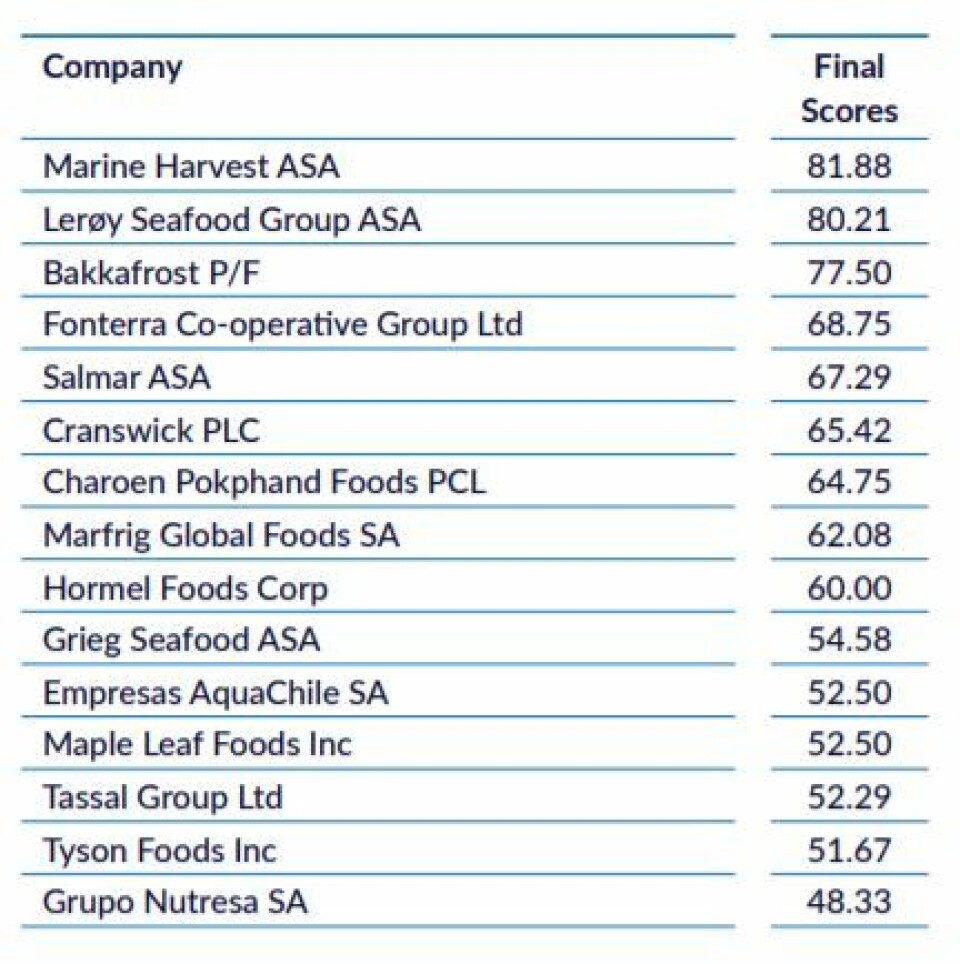
Salmon firms top list of sustainable intensive farmers
Salmon farming companies have come out best in an analysis of the sustainability risks of 60 global intensive farming companies.
Marine Harvest, Lerøy, and Faroese salmon farmer Bakkafrost were first, second and third respectively on the index which grades companies on health, environmental and social issues, and indicates where poor practices in those areas might be risking shareholder value.
SalMar, which jointly owns Scottish Sea Farms with Lerøy, was fifth, Grieg Seafood 10th, AquaChile 11th and Tasmania’s Tassal 13th.
Large investors
The Coller FAIRR (Farm Animal Investment Risk & Return) Protein Producer Index is produced for large investors by the $5.9 trillion investor network FAIRR, which lists Aviva Investors and Schroders among its members. The Index aims to improve corporate disclosure on sustainability issues by all major livestock and fisheries companies and bridge the knowledge gap for investors on this sector.
The Index was developed by combining environmental, social and governance (ESG) risk factors with the United Nations Sustainable Development Goals (SDGs).
The document includes 18 companies that have aquaculture products in their protein portfolio, with ten companies specialised only in aquaculture production.

Referring to the animal protein sector as a whole, the report states that “the mismanagement of antibiotics is the least addressed risk in an industry that is the world's leading consumer of antibiotics. More than three quarters (77%) of the companies in the Index classify as ‘high risk’ when it comes to administering and reporting antibiotics.”
Marine Harvest is highlighted for its approach to antibiotics. The company tracks antibiotics usage on a gram of active substance per tonne of product basis, and only uses antibiotics when fish are at risk. It aims to have “minimal” use of antibiotics by 2022.
SalMar is praised for having a comprehensive target to reduce its greenhouse gas emissions by 10% by 2020.
In the analysis, it is established that in general, aquaculture companies lead the animal protein sector in the quality of their reporting of critical sustainability problems.
The report adds that “the included freshwater systems (eg, tilapia, carp, catfish) have high consumption of fresh water compared to marine species, but present a lower risk in fish disease and escapes”.
It notes that for species such as salmon, which are cultivated in open waters, they use inputs from wild capture (fishmeal) or soy protein concentrate.
More controversially, the report, which included information from NGOs, adds that such species can devastate wild fish populations when they escape.
“The industry also faces a critical challenge of sea lice, which has been exacerbated with higher production volumes,” adds the report.
Methodology
All companies receive a general classification of low, medium or high risk, based on their scores against eight sustainability risk factors.
These are based on stakeholder understanding of environmental, social and governance issues and are specifically: greenhouse gas emissions; deforestation and loss of biodiversity; shortage of water and use; waste and pollution; antibiotics; welfare of the animals; working conditions; and food safety.
The eight risk factors and the key performance indicators (KPIs) were weighted equally, and each sustainability risk factor has several KPIs underlying its score.
The index highlights that Norwegian companies adequately report on the critical risks of their production, while Asian companies are quite deficient in this regard.
Finally, in terms of aquaculture, the report concludes that, “even the most sustainable animal proteins such as farmed fish, which consume less resources than terrestrial animals, and have a better record of risk management and disclosure, entail risks in its expansion, including the devastation of the marine ecosystem close to its production”.























































